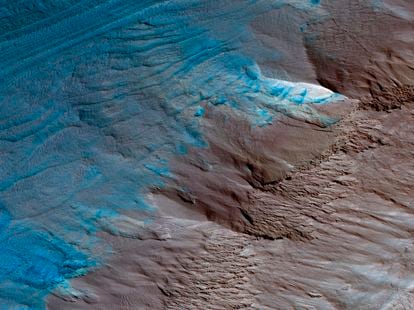The Mesopotamians called him Nergal, after their god of death, war, fire, plague, famine, and all the other horsemen of the apocalypse, but Mars must have had many other names before that. The red dot that periodically moves across the sky was already there when the first humans evolved in Africa and looked up at the night sky. Impossible not to see it, how impossible it now seems that humanity resists its pull as a second home. Exploring new worlds is in our nature, and no matter how many inconveniences the god Nergal may have, he will always have the advantage of being the closest planet and similar to ours.
Choosing the right time, traveling to Mars only takes eight months, which may seem like an eternity to an eager traveler, but which has already been overtaken by one-year stays on the International Space Station.
The astronaut who has broken the mark of permanence in the station, Scott Kelly, is completely ready to travel to Mars, as he assured this newspaper;
yes, as long as you have a return ticket.
There are many other people who would go even without a return ticket.
They want to be the first settlers to a new world, or perhaps the first to leave the old one.
More information
This is how we will live on Mars
There are people who are very pessimistic about the future of the Earth, and it must be understood, with arsenals of nuclear missiles that, despite all the international non-proliferation treaties, continue to treasure the power to destroy life on the planet, with a Numantine resistance of oil companies and governments to reduce emissions, with an increasing ability to rewrite viral genomes at will. Living on one planet is the astronomical version of putting all your eggs in one basket. As sober a scientist as Martin Rees, Astronomer Royal and former President of the Royal Society of London, estimates that as long as we do not colonize a second planet, our probability of surviving our own inventions does not exceed 50%. Like tossing a coin. This in itself already supposes an argument, albeit taciturn,to travel to our neighboring world.
Selfi taken by NASA's 'Curiosity' robot, on Mars, in October 2020.
In science, the important things never happened yesterday, as the logic of the press demands.
Although it seems to us that Mars has just become fashionable in these years, the truth is that the red planet already starred in the pilot episode at the very origin of modern science.
In his
Mysterium Cosmographicum
, or the mystery of the cosmos, of 1597, Kepler embraced the idea of Copernicus that the planets revolve around the Sun more slowly the further they are from it, and deduced from there that their orbits were due to a force coming from the star. Kepler called this force "vigor," which we now know as gravity. As historian John Gribbin points out, the previous best theory was that the planets were moved by angels, so that Keplerian "vigor" is the first model of the cosmos based on natural phenomena. And Kepler did not hide his motivation: "My purpose is to show that the machine of the universe is not like a being animated by God, but rather like a clock."
Four centuries ago there was no Amazon, so Kepler sent his
Mysterium
, paper version, to the great brains of the time, such as the young Galileo and the not-so-young Tycho Brahe, the greatest astronomer of the pre-telescope era.
Galileo did not respond, but Brahe - despite his ancient belief that the Earth was the center of creation - was truly dazzled by Kepler's mathematical talent, to the point that he invited him to join his select team of assistants.
It is more or less what the Silicon Valley giants do now: as soon as they see someone who stands out, they sign him and the competition is over.
Many people would be willing to go to Mars.
They want to be the first settlers of the new world
Javier Sampedro
Everyone knew, however, that the Brahe Observatory housed the most detailed data on the motion of Mars and the other planets in the night sky. And Kepler wanted to access that data like a vampire needs to suck the blood that feeds him. After four years of hardship and palace intrigues - reflected in The Wolves of Prague, an extraordinary novel by Benjamin Black - Kepler moved into the observatory and, in a second stroke of luck, Brahe fell ill, commissioned him to care for his legacy, and he died. They say that knowledge does not progress by persuasion, but by death. Kepler finally had what he craved to light the fuse of modern science, without irrational conservatism or religious mortgages. Or so he believed.
The data on the motion of Mars that Brahe had compiled in hopes of showing that the Earth was the center of creation served Kepler to prove just the opposite.
Mars actually followed an elliptical orbit around the Sun. And its movement accelerated when it approached the star and slowed down as it moved away from it, in a new manifestation of its idea of "vigor", what we now call gravity.
These empirical formulas, along with Galileo's experiments, led Newton to formulate the law of gravity, the first great unification of physics and the inspiration for four astonishing centuries of science.
Human knowledge owes a great deal to Mars.
And more than you will owe.
An image of the south pole of Mars.NASA / JPL-Caltech / Univ.
of Arizona
Beginning in the nineteenth century, when Giovanni Schiaparelli believed that he was observing enormous
canali
, or canals, on its surface, many people considered it probable or even assumed that there was intelligent life on Mars. Expectations were frustrated in 1964, when NASA's
Mariner 4
spacecraft analyzed its atmosphere: a thin layer of CO₂ and temperatures close to 100 degrees below zero. These are not conditions to host a civilization, no matter how much imagination one may throw at it. Why then have we Earthlings sent 28 unmanned missions to Mars, with 10 successful landings? What fascinates astrophysicists and exobiologists so much in that planetary desert hostile to life?
Mars is our second closest neighbor, after Venus, which is an even worse hell. If humans are an expansive, curious and adventurous species, as we have shown on Earth, and therefore our future is in the stars, Mars will be an almost forced first destination, if only because of cosmic nationalism. Today we also know that Mars was not always the arid and red world that we see today. 4 billion years ago, in the infancy of the solar system, it contained vast amounts of water and looked more like the blue planet we inhabit. Planetologists are most interested in knowing why this transition from blue to red occurred, from oasis to desert, from watery paradise to frozen dry land. The reason for this interest is not only geological. Imagine we had to put our beards to soak.
The closeness and the watery past are not the only arguments that Mars can exhibit as the inevitable destiny of humanity. The (now) red planet has winds and clouds, like Earth; a day that lasts about 24 hours, like the one on Earth; seasons throughout the year and polar caps, canyons and volcanoes like those on Earth. It even has some water left in the ground and perhaps seasonal water flows on the surface. Where there was water there may be life (or not), and it is conceivable that some of these hypothetical microorganisms would survive in today's watery waste. Few people would bet their money on that hypothesis, but the fact is that there is no problem of principle against it. We will have to look to see what is there. The rest are just ideas at the moment and, as British scientists say, ideas are cheap.The costly thing is to prove or disprove them.
Living on one planet is the astronomical version of putting all your eggs in the same basket
Javier Sampedro
In any case,
The War of the Worlds
imagined by HG Wells and broadcast with immense scandal by Orson Welles in 1938 - when in Spain there were invasions much more damaging than those of the Martians - is not going to happen, or at least not with the Martians proper, the nonexistent intelligent inhabitants of Mars.
And this, once the possible existence of microscopic life there has been analyzed or ruled out, opens up to humanity not a new continent of knowledge, but a whole and true planet.
Neither Alexander the Great nor Christopher Columbus would have dreamed of such a feat.
But scientists are doing much more than dreaming it.
They are seriously discussing how to do it.
The number of imaginative ideas and projects in the making about our planetary neighbor is endless to a single mind.
The detail-minded reader has a collection of articles by top Mars experts recently published as an e-book by Jesse Emspak for
Scientific American.
The little digital book is a treasure trove of information about the neighboring planet, what we have learned about it in recent years, projects to search for microbial life, the prospects of our species in that environment, new rockets from Elon Musk and everything else. .
You just have to know English and have seven dollars in your pocket.
Here we are going to focus on one of the most fascinating and futuristic ideas.
The
terraforming
of Mars.
Icy sand dunes of Mars.NASA
The neologism terraform, from the English
terraform
, means to turn a hostile planet into a friendly environment for humans. The term will be familiar to science fiction fans and perhaps less familiar to other Earthlings, but it is slowly moving into technical literature. If we knew how to do this, it would not only serve us for Mars, but for any planet with a suitable distance from its Sun that we can travel to in the very, very distant future. But Mars is the most predictable candidate for pioneering tests. According to physicists Christopher Edwards and Bruce Jakosky, a crucial question is whether the amount of CO₂ trapped in the subsurface is enough to make it worth moving into the atmosphere, making it more dense.
On Earth, the goal is to reduce CO₂ emissions into the atmosphere to slow global warming, but on a planet at 100 degrees below zero, warming would be a blessing. Scientists are not sure how to release CO₂ into the subtle atmosphere of Mars, but there are intrepid tycoons like Elon Musk - who this month predicted in
Time
that humans will travel to Mars in 5 or 10 years - who are quite clear: it would be enough to fry the planet's polar caps with nuclear bombs, the heat of which would release CO₂ from the poles into the atmosphere. It would be a good entry for our species on the Martian scene, no doubt, although perhaps an over-acted point. It is what tycoons have, who do not spare expenses or gestures, especially if they are in a hurry to save the world.
Musk's idea, however, seems impractical.
Not because of atomic bombs, but because the frozen CO₂ reserves at the poles of Mars are a trifle compared to what it would take to heat the planet to a point where liquid water is stable.
All the CO₂ emissions accumulated by humanity since the industrial revolution fall orders of magnitude short to terraform the red planet.
The bomb tycoon will have to wait for the real scientists to come up with a few more brilliant ideas than his own.
Minerals on the surface of the red planet.NASA / JPL-Caltech / MSSS
"Perhaps humanity's greatest resource is the imagination of the people," say Edwards and Jakosky.
"That imagination can be articulated by visionaries like scientists, entrepreneurs, inventors and political leaders, who can see beyond ours to a new and different future."
If science and the advanced societies that allow it do not commit suicide in an orgy of irrationality and destruction, we will arrive in time to overcome Martin Rees' bleak calculation, which leaves us only a 50% chance of surviving as a species.
The future will be what we decide.
Subscribe here
to the weekly Ideas newsletter.
Sign in to continue reading
Just by having an account you can read this article, it's free
Sign upLogin
Thanks for reading EL PAÍS







